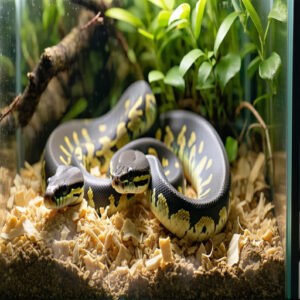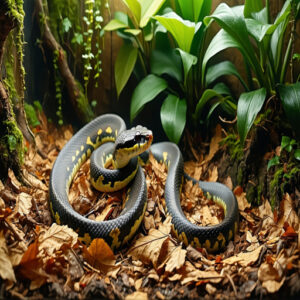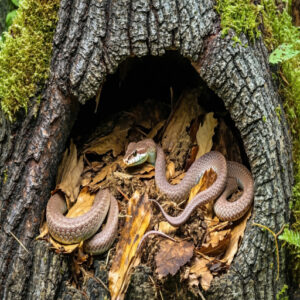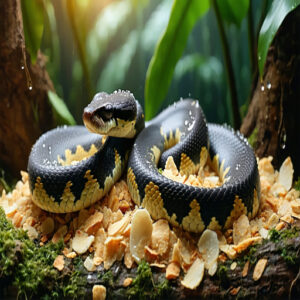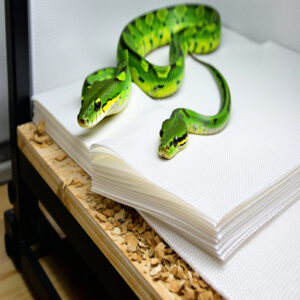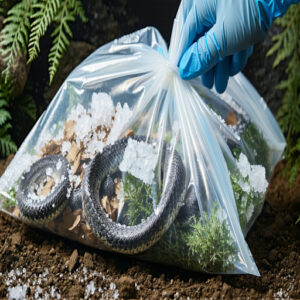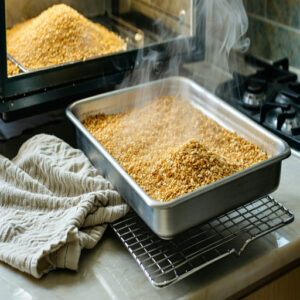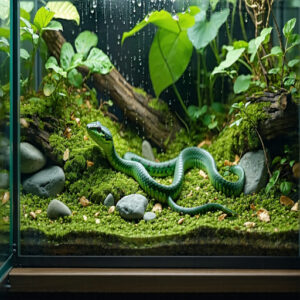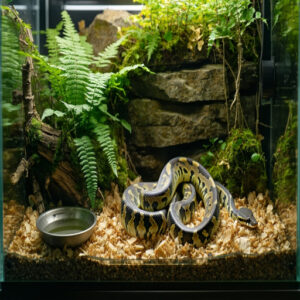This site is supported by our readers. We may earn a commission, at no cost to you, if you purchase through links.
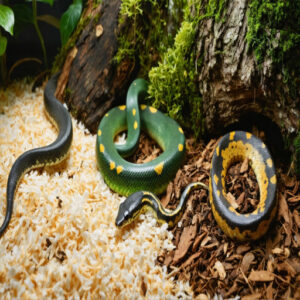 The best snake bedding really depends on your scaly friend’s needs.
The best snake bedding really depends on your scaly friend’s needs.
Aspen shavings are perfect if your snake loves burrowing, plus they’re low on dust—great for keeping their home (and your nose) clean.
Cypress mulch holds moisture like a champ and prevents humidity-loving snakes from drying out.
Coconut fiber or chips are soft, odor-controlling, and keep things cozy for smaller snakes.
For a forest-floor vibe, fir bark offers superior moisture control and a natural look.
Prefer low-maintenance? Paper liners are budget-friendly but need regular changes.
Want more details on setting up the perfect snake habitat? Let’s explore your options, considering moisture control, odor-controlling, and low-maintenance needs for the best snake bedding.
Table Of Contents
- Key Takeaways
- Types of Snake Bedding
- Preparing Your Snake’s Bedding
- 9 Best Snake Bedding Options
- 1. Aspen Snake Bedding by Zoo Med
- 2. Galapagos Cypress Tank Mulch Natural Bedding
- 3. Zilla Green Terrarium Liner
- 4. Prevue Hendryx T3 Cage Liner 14×25 Feet
- 5. Reptile Carpet Coconut Fiber Terrarium Mat
- 6. Reptile Bedding Coconut Chip Substrate
- 7. Cypress Tank Mulch Forest Floor Bedding
- 8. Flukers Repta Bark Natural Bedding
- 9. Bio Dude Terra Firma Reptile Substrate
- Bedding Maintenance and Care
- Selecting The Right Bedding for Your Snake
- Frequently Asked Questions (FAQs)
- Is coconut bedding good for snakes?
- What is the best bedding for a corn snake?
- What is the best snake bedding?
- What kind of bedding does a snake need?
- What is the best substrate for snake bedding?
- Which zoo bedding is best for snakes?
- What is the best bedding for a ball python?
- Can I use sand as a substrate for my snake?
- How often should I change my snake’s bedding?
- Is it safe to use pine shavings as snake bedding?
- Conclusion
Key Takeaways
- Choose bedding based on your snake’s needs: aspen shavings for burrowing, cypress mulch for high humidity, and coconut fiber for moisture and odor control.
- Avoid harmful materials like pine, cedar, or sand, as they can cause respiratory issues and other health problems.
- Regularly spot clean bedding and replace it every 4-6 weeks to maintain cleanliness and avoid bacteria buildup.
- Prep natural substrates by freezing or baking them to eliminate pests and ensure your snake’s habitat stays safe.
Types of Snake Bedding
You’ll find that choosing the right bedding for your snake is like picking out the perfect mattress for yourself – it needs to be cozy and practical.
From classic wood shavings to modern coconut substrates, each type offers unique benefits that’ll help keep your scaly friend happy and healthy in their home.
Wood Shavings
In the context of snake bedding, wood shavings are your go-to choice for a healthy habitat.
While pricier than newspaper, they’re worth every penny for your scaly friend’s comfort.
- Aspen shavings offer superior dust reduction and spot-cleaning ease
- Terra firma wood shaving provides excellent absorption – handles a full water bowl
- Wood pellets create a natural burrowing environment
- Safe for all snakes, unlike cedar or pine varieties
- Easy maintenance keeps your snake’s home fresh and clean
For ideal results, consider using a reptile substrate that’s both odorless and renewable.
Mulch
Why do snake enthusiasts love mulch as a bedding option?
In the case of cypress mulch snake bedding, you’re getting a natural powerhouse that keeps your scaly friend comfy and healthy.
For other excellent choices, explore the best snake bedding options.
- Mulch types like cypress are moisture-retention champions, perfect for humidity-loving species while preventing scale rot
- You’ll love how it lets your snake follow natural burrowing instincts, creating cozy hideaways just like in the wild
- Maintenance is straightforward – just freeze overnight to zap mites, then wash and bake for a fresh start
Remember to spot-clean regularly and monitor moisture levels to keep bacterial growth in check.
Bark
Looking to level up from mulch? Bark substrate might be your next move.
Whether you’re eyeing Flukers ReptaBark or other wood chips, bark types from fir trees create an awesome forest floor vibe in your snake’s home.
It’s like having a mini ecosystem – the bark benefits include premium moisture control and heat distribution.
Your scaly friend might even try some burrowing action, though it’s not as dig-friendly as other options.
You can find a variety of reptile bark bedding products online.
Just remember to freeze new bedding overnight to zap any unwanted guests, and give it a hot water bath every few months to keep things fresh.
Coconut
From the tropical shores to your snake’s enclosure, coconut fiber bedding brings a slice of paradise home.
Whether you’re using loose coconut husk or compressed coconut chips, this natural substrate keeps your scaly friend comfy while tackling moisture and odor control like a champ.
You can find various coconut bedding products online.
- Coconut fiber substrate locks in humidity perfectly for tropical species
- Coconut husk naturally neutralizes those funky pet odors
- Coconut chip bedding helps maintain steady temperatures
- Coconut mats provide a smooth surface for less-active snakes
- Coconut oil in the fibers adds antimicrobial properties
Just watch that your snake isn’t snacking on the substrate – we want them dining on mice, not coconuts!
Paper and Fabric Liners
While coconut bedding excels in moisture retention, paper and fabric liners offer a different approach to habitat care.
They’re like your snake’s personal mattress – flat and simple, yet effective.
Paper options need frequent swaps, but fabric liners boost absorbency and cushioning.
Here’s a quick comparison:
| Feature | Paper Liners | Fabric Liners |
|---|---|---|
| Cost | Low | Moderate |
| Durability | Single-use | Long-lasting |
| Maintenance | Daily/Weekly | Monthly |
Want the easiest cleanup? These zoo med snake bedding alternatives won’t let you down.
Preparing Your Snake’s Bedding
You’ll want to prep your snake’s bedding properly to keep those unwanted creepy-crawlies away from your scaly friend.
Before placing any substrate in your snake’s habitat, you can freeze natural materials for 24 hours or bake them at 250°F for 30 minutes to eliminate potential pests.
Freezing Natural Substrates
Your bedding prep game-changer starts with frozen storage.
Place natural substrates in an airtight bag and freeze at 0°F for 48 hours – it’s nature’s way of substrate sterilization.
This freezing method doesn’t just zap unwanted visitors; it maintains perfect substrate moisture levels for your scaly friend.
Best of all, your burrowing substrates stay fresh without harsh chemicals, making natural preservation a breeze.
Washing and Baking Bedding Materials
Keeping your snake’s habitat safe starts with clean bedding—you wouldn’t want your pet lounging in what could be a pest party, right? Here’s how to nail it:
- Wash the Bedding: Washing snake bedding is a must, especially for natural materials like bark or coconut husk. Rinse thoroughly to remove dust, dirt, or loose particles. For fabric or paper liners, toss them in the laundry but skip harsh soaps.
- Bake It: Baking aspen bedding or other natural substrates at 250°F for about 2 hours removes pesky mites and bacteria. Think of it as a spa day for your snake’s home!
- Store Smart: Keep unused bedding sealed in airtight bags or bins to avoid contamination.
- Safety First: Stick to organic options and skip anything chemically treated. Bedding hygiene = happy snake. For a more detailed exploration into bedding options, explore this guide on choosing snake bedding.
Bonus tip: Check substrate moisture levels regularly to avoid mold surprises.
Choosing Reputable Brands
Before settling on the best snake bedding, trust reptile brands like Zoo Med and ReptiChip that excel in product testing and quality control.
Check out customer reviews and market trends to spot top options.
Reliable brands simplify care while ensuring safety.
Here’s how popular ones stack up:
| Brand | Known For | Price Range |
|---|---|---|
| Zoo Med | High-quality Aspen | Mid to High |
| ReptiChip | Organic Coconut | Mid-Range |
| Zilla | Easy-Clean Liners | Budget-Friendly |
9 Best Snake Bedding Options
Picking the right bedding for your snake isn’t just about looks—it’s about keeping them comfy, clean, and healthy.
From moisture-loving options to easy-to-clean liners, here’s a rundown of the best choices to suit your scaly friend’s needs.
1. Aspen Snake Bedding by Zoo Med
Choosing Zoo Med Aspen Snake Bedding means making your life easier while keeping your snake happy.
This stuff isn’t just bedding—it’s like a cozy burrow your pet would dig in the wild.
With an impressive 191% absorbency, it controls moisture like a champ and keeps bad smells away (your snake won’t complain, but you might).
Worried about dust? Don’t be—this bedding is 99.9% dust-free, so no sneezing reptiles here.
Plus, it’s safe for all snakes—no harmful oils or weird chemicals to stress over.
Cleaning is a breeze too, saving you time.
Made from renewable resources, it’s eco-friendly and biodegradable, which is great for Earth.
Perfect for burrowers, this bedding lets your snake feel right at home.
Lightweight and versatile!
Best For: Snake owners looking for a safe, eco-friendly, and easy-to-maintain bedding that supports burrowing and mimics natural habitats.
- Extremely absorbent with 191% moisture control.
- 99.9% dust-free and non-toxic, reducing respiratory risks.
- Easy to clean and biodegradable for eco-conscious pet care.
- Prone to mold if not replaced frequently.
- Unsuitable for snakes requiring high-humidity environments.
- Can be messy to handle and slightly more expensive than alternatives.
2. Galapagos Cypress Tank Mulch Natural Bedding
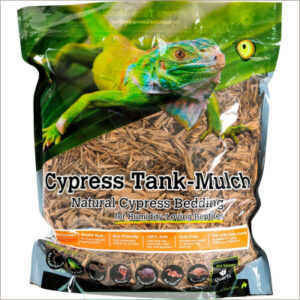
Looking for a cozy, natural option for your snake’s home?
Galapagos Cypress Tank Mulch delivers on comfort, moisture control, and sustainability.
This bedding is made from cypress trees, offering exceptional absorbency to keep tropical setups humid and snake-friendly.
Plus, tiny bark pieces encourage natural behaviors like burrowing and feeding.
You can find a variety of cypress snake bedding products available online.
What’s great? It’s eco-friendly—crafted from timber by-products without nasty chemicals, oils, or parasites.
The material is washed and sieved to clear out dust, which means a safer, sneeze-free environment for your slithery buddy.
The resealable bag? A lifesaver for maintaining freshness and keeping your investment long-lasting.
While it shines in larger terrariums, you can also mix it with Tropicoco Soil to create the ultimate lush, natural habitat.
Whether you’ve got a picky python or a chill turtle, this bedding ticks all the boxes for quality and ease.
Best For: Reptile and amphibian owners looking for a natural, eco-friendly bedding that promotes moisture control and supports tropical habitats.
- Eco-friendly and sustainable, made from timber by-products without chemicals or parasites.
- High absorbency for controlling humidity in tropical setups.
- Washed and sieved to reduce dust, creating a cleaner environment.
- Some customers report issues with excessive dust despite claims of sieving.
- Opinions are mixed on bark size, with some expecting larger pieces.
- Potential bug issues reported by a few users.
3. Zilla Green Terrarium Liner
Ever wish snake bedding was as easy as "set it and and forget it"?
The Zilla Green Terrarium Liner might be your answer.
Think of it as rolling out a comfy green carpet your snake won’t try to eat—a win-win for both of you!
It is treated with a biodegradable enzyme, it keeps odors under control without any fuss.
Plus, it’s super absorbent and soft, ensuring your snake stays cozy and irritation-free.
Sized to fit most tanks (and cuttable for odd shapes), it’s perfect for a tidy, low-maintenance setup.
Just rinse to clean and reuse—it’s that simple.
If you’re especially worried about bedding getting swallowed, this liner’s design prevents those mishaps.
Affordable, reusable, and snake-safe, it’s a hassle-free choice you’ll love.
Best For: Owners who want a low-maintenance, safe, and reusable bedding alternative for their reptiles, especially those prone to ingesting loose substrates.
- Easy to clean and reusable, reducing waste and effort.
- Prevents accidental ingestion, ensuring snake safety.
- Absorbent and soft, keeping reptiles comfortable and irritation-free.
- Does not provide depth for snakes that like to burrow.
- Needs cutting to fit non-standard tank sizes.
- Requires regular rinsing and replacing monthly to stay effective.
4. Prevue Hendryx T3 Cage Liner 14×25 Feet
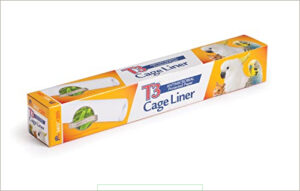
If you’re all about keeping your snake’s spot tidy with minimal hassle, the Prevue Hendryx T3 Cage Liner might just become your go-to bedding choice.
Made from durable polyethylene, this liner is like the unsung hero of easy cage maintenance—it’s clean, simple, and reusable.
Forget the scrubbing marathons; just wipe it down, and boom, you’re done.
It’s perfect for those who want a no-mess, no-stress setup.
However, this liner doesn’t allow burrowing (so, no digging fun here).
If your snake loves to tunnel, think of it as the “rest stop” bedding—clean for a bit, but changed out for something cozier later.
It’s all about balancing practicality with your snake’s comfort!
Best For: Snake owners who prioritize easy cleaning and low-maintenance bedding over burrowing features.
- Durable and reusable polyethylene material for long-term use.
- Easy to clean with simple wipe-down maintenance.
- Pre-cut to fit standard 14.5 x 25-inch cages, saving time during setup.
- Not suitable for burrowing snakes that enjoy tunneling.
- Lacks absorbency compared to natural bedding options.
- May need to be combined with other bedding for enhanced comfort or functionality.
5. Reptile Carpet Coconut Fiber Terrarium Mat
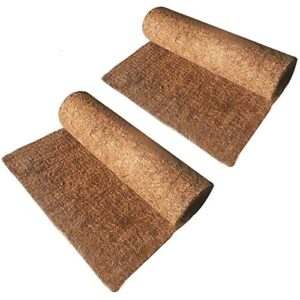
Your pet deserves comfort, and the Reptile Carpet Coconut Fiber Terrarium Mat delivers just that.
Made from natural coconut fiber, this mat creates a cozy and breathable home for your snake while keeping things tidy.
It’s safe, preventing irritation and protecting against moisture, dirt, and scratches—perfect for ensuring your snake stays happy and healthy.
Cleaning is a breeze: just rinse it with cold water, shake off the debris, and hang it to dry.
Thanks to its durable build, you’ll get plenty of mileage out of it.
Plus, it’s versatile—you can easily cut it to match your tank’s size (just get those measurements right to avoid the dreaded "oops!").
If you’re after something simple, effective, and reusable for your snake’s habitat, this mat ticks all the boxes.
Best For: Reptile owners looking for a safe, natural, and reusable substrate that’s easy to clean and maintain.
- Made of natural coconut fiber, safe and non-abrasive.
- Easy to clean with water and dries quickly.
- Can be custom-cut to fit any tank size.
- Not suitable for high-humidity environments as it may retain excess moisture.
- May require frequent cleaning to prevent debris buildup.
- Limited to smaller or medium-sized tanks unless multiple mats are combined.
6. Reptile Bedding Coconut Chip Substrate
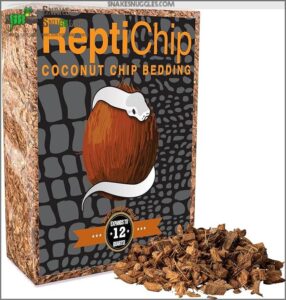
Looking for bedding that checks all the boxes? Reptile Bedding Coconut Chip Substrate is like the Swiss Army knife of snake habitats.
It’s dust-free, easy to use, and perfect for both humid and dry setups.
Need more moisture? Soak it to expand and boost humidity.
Bonus: it keeps your snake comfy while soaking up odors like a pro.
Whether you’re housing a python, boa, or gecko, this all-natural, eco-friendly option makes creating the perfect home for your pet a breeze!
Best For: Reptile owners looking for a versatile, eco-friendly substrate that works well in both dry and humid environments.
- Dust-free and absorbs odors, keeping enclosures cleaner.
- Can be used dry or soaked for higher humidity levels.
- Made from organic, sustainable coconut husk, safe for reptiles.
- Only available in two size options.
- Requires soaking for high-humidity setups, adding prep time.
- Not pre-packaged in resealable bags for convenient storage.
7. Cypress Tank Mulch Forest Floor Bedding
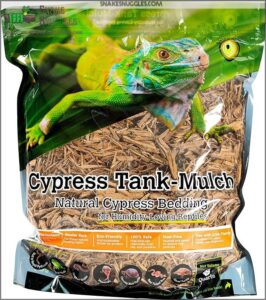
Ever wish your snake’s enclosure felt like a jungle floor?
Cypress Tank Mulch Forest Floor Bedding nails that vibe!
Its natural, earthy look pairs perfectly with tropical setups while absorbing moisture like a sponge to keep humidity on point.
This mulch suits various reptiles, from snakes to salamanders, and even stops crickets from sneaking underfoot.
Just remember: no soggy messes—keep it dry and swap it out regularly.
For jungle vibes without the bugs, this bedding is a low-effort, high-reward win.
Best For: Reptile owners looking to create a natural, humid environment for tropical species like snakes or salamanders.
- Absorbs moisture effectively to maintain proper humidity.
- Natural appearance enhances tropical enclosures.
- Free from parasites, salt, and harmful chemicals.
- Can become dusty if not replaced regularly.
- Mixed reviews on overall quality and consistency.
- May not hold moisture as well as some users expect.
8. Flukers Repta Bark Natural Bedding
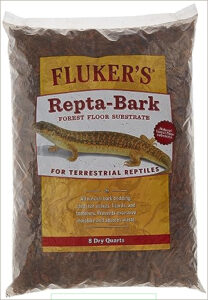
If you’re after a no-fuss substrate for high-humidity reptiles, Fluker’s Repta-Bark is a crowd favorite.
Made from orchid bark, it’s perfect for locking in moisture and soaking up waste, cutting down on odors and mess.
For king snakes, understanding proper substrate selection is essential for their health and well-being.
The larger chunks mean less dust (your lungs will thank you) and a lower chance your pet accidentally swallows any—because let’s face it, snakes aren’t the most careful eaters.
Repta-Bark works like a charm for snakes, lizards, and even tortoises, providing a comfy burrowing zone for critters who like to hide.
Just spread a 2–4-inch layer in their terrarium and check daily for messes (a plastic scoop works great).
Replace entirely every month to keep things squeaky clean and avoid any funky smells or skin issues.
Bonus: it’s easy to clean and makes your pet’s habitat look natural and inviting.
A win-win!
Best For: Reptile owners looking for a natural, odor-reducing substrate suitable for high humidity and burrowing species like snakes, lizards, and tortoises.
- Absorbs moisture and waste effectively, reducing odors.
- Large chunks minimize dust and accidental swallowing by pets.
- Easy to clean and provides a natural, attractive look.
- Requires full replacement every month, which adds upkeep.
- Higher upfront cost compared to some other substrates.
- Not suitable for reptiles that thrive in low-humidity environments.
9. Bio Dude Terra Firma Reptile Substrate
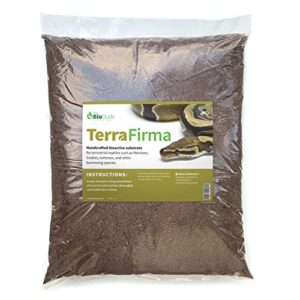
Think of the Bio Dude Terra Firma Reptile Substrate as the ultimate all-in-one solution for your snake’s habitat.
This handcrafted mix is designed to mimic the natural forest floor, providing a perfect balance for comfort and health.
It holds moisture, maintains tunnels, and supports bioactive setups like a pro.
Plus, it’s plant-friendly, creating an ideal environment for tropical or succulent greenery.
Add critters like springtails or isopods to turn it into a self-cleaning, low-maintenance ecosystem.
No drainage layer? No problem—it’s built for simplicity!
Whether you’ve got a ball python or a king snake, they’ll love burrowing in this substrate that stays airy, absorbs moisture, and promotes hydration.
It’s the low-effort, high-impact bedding option you’ve been waiting for.
Best For: Reptile owners with burrowing species like snakes, monitors, or fat-tail geckos who want a bioactive setup that supports plants and promotes animal health.
- Maintains burrows and tunnels while providing proper aeration and moisture retention.
- Supports plant growth, including succulents and tropical varieties, with no drainage layer needed.
- Promotes a bioactive, self-cleaning ecosystem when paired with critters like springtails or isopods.
- Requires regular monitoring to maintain proper substrate conditions.
- Does not include necessary additions like BioShot or insects; these must be purchased separately.
- Shipping can take up to 5 business days and only ships via FedEx.
Bedding Maintenance and Care
Keeping your snake’s bedding clean isn’t just about keeping odors down—it’s essential for their health and comfort.
With regular spot cleaning and weekly bedding changes, you can avoid bacteria buildup and keep their habitat fresh.
Weekly Changes
Every week, fresh bedding equals a happier, healthier snake.
Regular snake bedding maintenance isn’t tough but necessary for odor control and preventing unwanted bacteria.
Here’s your weekly bedding rotation checklist:
- Substrate Replacement: Swap out soiled materials for fresh ones.
- Humidity Checks: Confirm the new bedding supports proper moisture levels without overdoing it.
- Snake Monitoring: Look for signs of discomfort like burrowing struggles—your snake knows best!
Stick to cleaning schedules for a thriving, clean terrarium!
Spot Cleaning
A clean habitat starts with spot cleaning—it’s quick, easy, and keeps odors in check.
Daily checks make a huge difference, letting you grab waste before it becomes a bigger issue.
Here’s a simple method:
- Scooping: Use a litter scoop for solid waste—it’s fast and effective.
- Scraping: Plastic cards handle tough spots like urates on liners.
- Spraying: Terrarium cleaners loosen residue for easy removal.
Spot cleaning complements weekly bedding changes, improving odor management and humidity control while keeping your snake comfy.
Regular snake cage cleaning practices are essential for maintaining a healthy environment for your pet.
Mixing Bedding Types Safely
Want to try mixing snake bedding types? Done right, it’s genius. Combining options like aspen and orchid bark creates cozy, practical substrate blends.
But here’s the catch: focus on safe mixing to avoid trouble. Keep humidity control in check—damp bedding can invite mold or bacteria.
Plus, consider your snake’s size, color, and activity level. A balanced bedding layering helps with odor management and comfort too. Always test small blends first because, hey, safety’s better than cleanup chaos!
Selecting The Right Bedding for Your Snake
Choosing the right bedding for your snake keeps them comfortable, healthy, and stress-free. It’s not just about looks—think about their species, habits, and even how messy they are!
Considering Snake Morph and Color
Not all snake bedding works for every snake species.
A snake’s morph and color can influence the best choice.
For brighter morphs, avoid newspaper or ink-staining materials.
Darker snakes may "disappear" on dark substrates, while the right backdrop enhances visual appeal and monitors waste.
Need moisture? Go for reptile bedding like cypress mulch.
Want dryness? Try aspen.
Match bedding with natural habitats for snake camouflage and comfort—it’s like redecorating, but for reptiles!
Avoiding Wet or Bacteria-Prone Substrates
A soggy substrate is like a welcome mat for trouble—think bacteria, fungal growth, and even scale rot.
Stick to moisture control with dry environments in mind, avoiding bacteria-prone substrates like reptile carpet (if unwashed) or paper towels that need constant swapping.
Sterilize natural substrates through freezing or baking to keep things safe, and for snakes that burrow, choose options with good odor absorption without risking bacterial growth.
Remember, humidity management doesn’t mean damp chaos—strive for balance to keep your snake cozy and germ-free!
Risks of Using Kitty Litter
Let’s cut to the chase—kitty litter is a health hazard for snakes.
It leads to serious troubles like toxic fumes and respiratory issues, thanks to its dusty and chemical-filled nature.
Then there’s the risk of deadly intestinal blockages if ingested.
Want safe snake bedding? Stick to snake-specific substrates that prioritize comfort and avoid these dangers entirely.
Keep it simple, keep them safe!
Frequently Asked Questions (FAQs)
Is coconut bedding good for snakes?
You’ll love coconut bedding for its moisture retention and odor control—perfect for high-humidity snakes.
It looks natural and feels cozy, though regular cleaning is key to keep mites away.
Snakes thrive, and you relax!
What is the best bedding for a corn snake?
You can’t go wrong with aspen bedding for your corn snake.
It’s soft, absorbent, and perfect for burrowing.
Avoid cedar or pine, though—they’re toxic to snakes!
Keep it clean, and your snake will thrive.
What is the best snake bedding?
Not all bedding is equal—what works for a desert vibe might fail a rainforest setup.
Aspen shavings are versatile for burrowers, while coconut fiber wins for humidity lovers.
Always dodge pine, cedar, and sand.
What kind of bedding does a snake need?
Your snake needs bedding that’s absorbent, safe, and suited to its species.
Options like aspen shavings, cypress mulch, or even paper towels work well.
Avoid pine, cedar, or sand—they can cause serious health issues.
What is the best substrate for snake bedding?
Think of bedding your snake’s mattress—it’s all about comfort and function.
Cypress mulch rules for humid setups, while aspen shavings work for dryness.
Coconut fiber? Perfect for burrowers.
Match bedding to your snake’s needs!
Which zoo bedding is best for snakes?
You’ll love Zoo Med Aspen Snake Bedding for its absorbency and burrowing appeal.
You can also consider Zoo Med Forest Floor Cypress Mulch for high humidity.
Both are snake-friendly, low-maintenance options, giving your scaly buddy a comfy, safe spot.
What is the best bedding for a ball python?
For a ball python, cypress mulch or coconut husk works wonders.
They hold humidity like champs, which your python needs.
Bonus: they’re cozy for burrowing!
Avoid sand or anything dusty—it’s like offering bad snacks.
Can I use sand as a substrate for my snake?
Sand’s risky business for most snakes—it’s dusty, abrasive, and can cause blockages if swallowed.
Some desert species use it safely, but generally, skip sand unless you’re up for constant cleaning and vet worries.
How often should I change my snake’s bedding?
Ever wonder if your snake’s bedding is overdue for a change?
Spot clean weekly, but do a full bedding swap every 4-6 weeks.
For messy eaters, you might need more frequent overhauls.
Is it safe to use pine shavings as snake bedding?
Pine shavings aren’t snake-safe due to toxic aromatic oils that can harm their respiratory system.
It’s like offering them a scratch-n-sniff hazard.
Stick to snake-approved options like aspen or cypress for healthier, stress-free reptiles!
Conclusion
Funny how something as simple as snake bedding can feel so complicated, right?
But the right choice—whether it’s aspen shavings, cypress mulch, or even a trusty paper liner—makes all the difference in your snake’s health and comfort.
Think about your snake’s species, humidity needs, and habits before diving in.
The best snake bedding keeps their environment clean, manages moisture, and fits your routine, and when you pick wisely, your scaly buddy will thank you (in their own silent way) for a comfortable and healthy environment with the right humidity needs.

